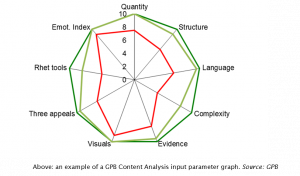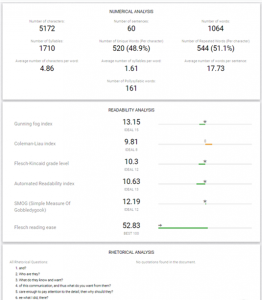“We’re Following the Science!”
Des looks at how GPB’s Scientific Analyses can help you
In recent times here in the UK, the phrase in my title (above) has frequently been heard in public pronouncements about the devastating Covid-19 pandemic. There’s also been some accompanying debate about what the phrase means exactly, and whether the claim made has been consistently true.
But that’s not what I want to discuss here. Instead, I reference this phrase because it echoes how we work at GPB. I’ll explain how we “follow the science” ourselves, what that means, and how we use that science to your advantage.
Perhaps you’re luck y enough to be too young but in MY head, incidentally, that phrase also recalls happy childhood memories of Holiday ‘Disney Time’ TV shows (1961-’98). And of one particular, up-beat, frequently featured film clip: ‘Following the Leader’ sung by The Lost Boys, from Disney’s ‘Peter Pan’ (1953)1 .
y enough to be too young but in MY head, incidentally, that phrase also recalls happy childhood memories of Holiday ‘Disney Time’ TV shows (1961-’98). And of one particular, up-beat, frequently featured film clip: ‘Following the Leader’ sung by The Lost Boys, from Disney’s ‘Peter Pan’ (1953)1 .
Maybe you’ve already experienced parts of GPB’s unique suite of three Scientific Analyses first-hand? After all, they’re key components in the powerful armoury of Science and Art that helps us to develop our clients’ communication skills.
Scientific analyses
People are intrigued when they first hear about our Scientific Analyses, and are then keen to experience them. GPB offers three areas of Scientific Analyses: Vocal, Visual and Content.
In each of these, we use objective measures to get a baseline reading which informs our advice.
We share these reports in confidence with each individual and recommend development areas. We explain what’s been measured and how that was done. The reports are balanced, since they identify both strengths and development areas for discussion.
People are generally happier to discuss their development and engage more completely when they know they’ve been objectively assessed. This results in quicker, greater and longer-lasting improvements, saving time, money and effort. A win for everyone!
I won’t cover our Vocal and Visual analyses further here, as they’ve been well covered in prior articles. Instead, we’ll focus on our Scientific Analysis of Content. That’s a crucial area because, even if your vocal and visual delivery are second to none, if your content isn’t optimal then that great delivery may largely go to waste.
Content Analysis
For Content Analysis, we use specially developed GPB digital software, in combination with analogue analysis. This assesses sample documents and narratives against a number of key persuasiveness measures. I will return to those later.
We analyse documents and speech narratives using up to 12 parameters. An example input radiograph is shown on the next page. We compare each of the scores obtained against those from reference samples of the most effective content.
The results are put into an algorithm that gives us output measurements of parameters such as efficiency, clarity, brevity, credibility and, ultimately, the persuasiveness of the content.
Our analysis offers recommendations at the macro and micro levels. Our aim is to help you craft more persuasive communication for your readers or listeners. Each piece of advice shared below benefits from a large body of thought and scientific research. Their cumulative impact can be huge.
“Big picture”, macro level advice prompted by our analysis may include:
- Think more deeply and fully about your readers or audience. Who are they? What do they know and want? What is the true purpose (Telos) of this communication, and thus what do you want from them? Be clear on such questions from the outset
- Create a storyboard with a clear sequence that’s easy to follow – so nobody gets distracted or lost in a complex mental maze
- Restrict yourself to only a few Key Messages, perhaps even just one. That provides focus for you, and makes things simpler for them to follow
- Provide compelling evidence in support of your points – e.g. data, statistics, examples, case studies, quotations and visual aids. There’s a “Leap of Faith” required from them about anything forward-looking. They will make that leap far more happily if your “proof” is convincing, relevant and of several types.
- Tap into the power of story-telling, to engage them more fully. Humans find stories rewarding. Because they trigger reactions in more areas of our brains than merely hearing a recital of facts and figures. This can result in a more directly experiential personal engagement.
Here’s some advice we offer at a more detailed, micro level. It includes key aspects of language choice and use:
- Be concise – if you don’t need a word, cut it out. Every extra word is more effort for the reader or listener. Don’t waste their time or effort — or yours. Make every single word count
- Use short words rather than long ones – they’re much easier to follow!
- Write/speak to express, not to impress. Be understood first time. If the audience is distracted or confused, your message/s may become diluted, or lost entirely.
- Avoid “typos”, poor punctuation and grammar. This helps your credibility. If you don’t care enough to pay attention to the detail, then why should they? It’s surprising how often even the use of Spellcheck is forgotten. It usually spots about half of the errors, so do a manual check
- Content should be in the active not passive tense where possible, and be personal rather than impersonal.
- Anglo-Saxon words typically have fewer syllables, so are shorter than polysyllabic vocabulary (see what I did, there?). The latter are commonly words of Latin or Greek origin
- Use shorter sentences, whether speaking or writing. This helps your audience to follow you. Aim for an average of less than 20 words per sentence when writing, and about 12 words per sentence when speaking
- Write creatively for their enjoyment, stimulation, and provocation. This helps keep them engaged and actively considering your ideas
- Use Rhetorical Tools to make your content more powerful. A full list with definitions and examples are shared on our dedicated webpage:
https://www.gpb.eu/2020/03/rhetorical-tools-list.html3.
Just for fun, I’ve run this article through our content analysis software. The table of results is shown below.
As I hope you’ve seen, we genuinely do “follow the science”. Doing so ensures we have the most solid base on which to give the best possible advice.
Helped on our way by GPB’s objective Scientific Analysis data, none of us need fear looking like Lost Boys or Girls, on the twisty-turny road to more effective and persuasive communication. Feel free to join in and sing along with me, now:

By Des Harney
References:
- ‘Following the Leader’ (1953): by Oliver George Wallace, Ted Sears and Winston Hibler. Adapted (by just one word) in my final sentence. Available at https://disney.fandom.com/wiki/The_Disney_Wiki?file=Disney%27s+%22Peter+Pan%22+-+Following+the+Leader
- We’re Following the Leader!”
Image source: DisneyWiki – https://disney.fandom.com/wiki/Following_the_Leader?file=Peterpan-disneyscreencaps-3374.jpg - Rhetorical Tools – GPB website (see link in text)



